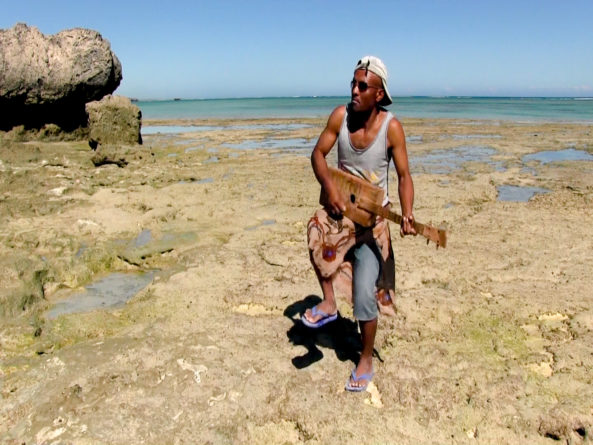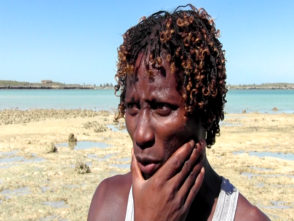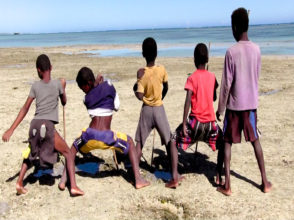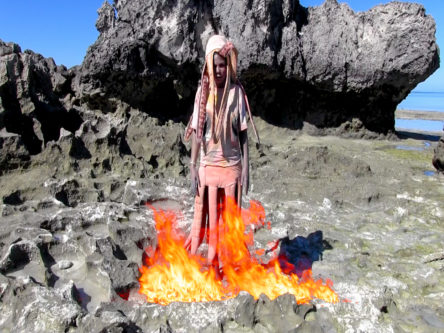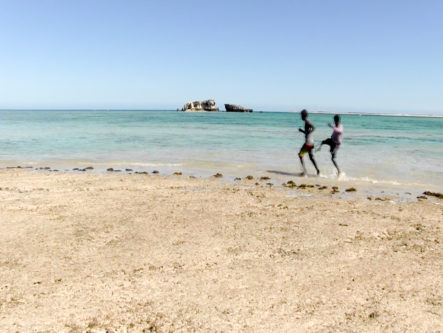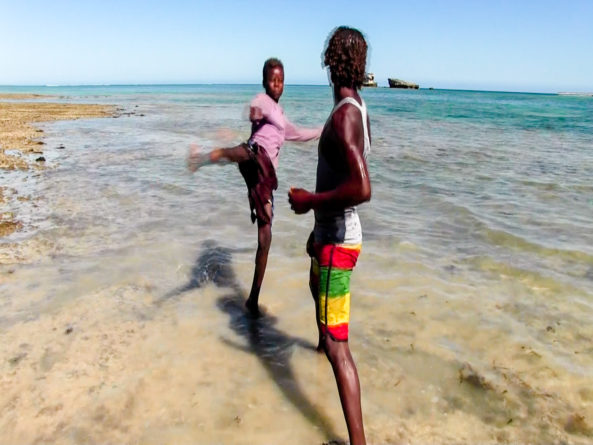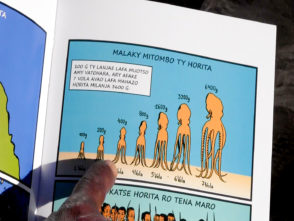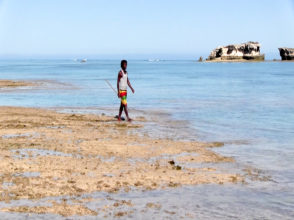In late 2016 our team worked with communities in southwest Madagascar to produce a popular film that promotes good fishing practices for the octopus fishery. Now that we’ve launched the film online for use by partners, we spoke with Xavier Vincke and Paul Antion about making the film and its impact so far.
What was the aim of the film?
Xavier: Our work with communities in southwest Madagascar has focused on the octopus fishery as an entry point to the local management and conservation of resources. So far, the temporary closure model has demonstrated that communities can make money from managing the fishery, however aside from temporary closures there is more that needs to be done to make sure the fishery is sustainable. Community leaders reported struggling to make sure that everyone respects the dina (local law) about good octopus fishing, and we wanted to make an outreach tool to help spread the word about the rules, and the reasons behind them. We decided to use film as we’ve seen it has the power to bring in quite a crowd.
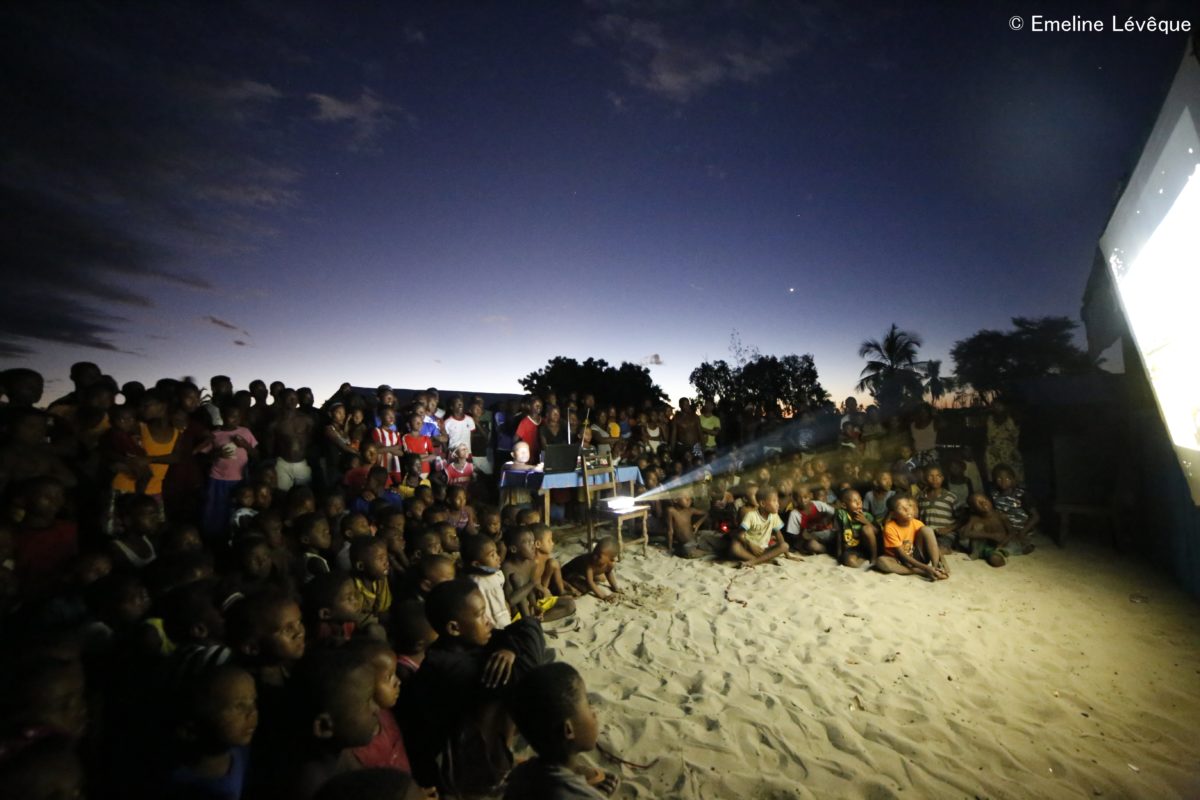
Whether it’s an action, a comedy or some music videos, people gather to watch when films are put on.
Can you tell us how you and the team came up with the concept and the story for the film?
Even in the most isolated fishing village, on any tiny island, there’s a place run by a local entrepreneur with a generator, where people gather at night to watch action movies, music videos and comedies.Xavier: We wanted to make a film that people really wanted to watch, that would have a clear and relatable message. So first of all we knew it had to be in the local language and feature local people and places. Then, we started by talking about the movies that are popular in the villages in order to work out how to structure our film. From these conversations we decided our film had to include action, fun, magic, music and dance, all woven into a story. We worked with a few of our close partners from the community at each stage, who gave us their ideas and gave us their feedback on our final script. So that’s how we ended up with a film in Vezo dialect that includes kung fu, kilalaky [a local dance style] and octopus fishing!
Can you describe how the film was shot?
Xavier: it was an intense effort. We planned the story out carefully in advance and wrote the script. In the run up to filming, Paul and Hery from our outreach team in Andavadoaka worked hard to cast all the main parts. The actors were all community members who volunteered to take part – luckily there was lots of interest!
Our main character Tovo is actually a Blue Ventures staff member called Fredo – a boat skipper working for our expeditions programme. He’s well known for making everyone laugh, so that was an easy choice. Hery also played the role of the poor fisherman who didn’t respect the good fishing practices, and a few other Blue Ventures team members appear in the film.
None of our actors had ever taken part in a film before, and learning the lines was challenging. Some scenes ran to ten or more takes to get it right, sometimes with a crowd of twenty people huddling around to encourage the actor!Despite good planning, we still had some last minute hurdles when our actors were suddenly not available. Luckily, given the interest generated by us filming, we could always find someone ready to step in within a few minutes.
We knew music was a central component of the film, and we’re lucky to have a very talented musician and composer within our team in Andavadoaka. Sylvere, who appears in the film playing the kabosy [a local stringed instrument], composed the theme song “Kilikiliho” (Tickle it) in just one night. Sylvere then also took a leading role in directing the others in the dancing at the end of the film.
Paul: Xavier used some special effects in this film that haven’t been seen in any local film. Ela, another Blue Ventures staff member, played the octopus mermaid who appears and disappears out of a fire on the rocks. The scene is always greeted with gasps, and laughs as Tovo is just as startled. Ela has told me that people have come up to her asking how she learned to disappear like that!
How was the movie received?
Xavier: I’m very proud to say that our efforts to make the film popular and engaging worked! During a tour of the villages to screen the film we saw people walk several kilometres to the next village to watch it again the next night. When I walked around the villages after a screening I could hear kids singing the song all over the place!
Somehow the film had leaked out before and children were already shouting Tovo’s lines before they came, and sang along with the song even during the first time we played it. This is pretty much how all of the showings have gone since.Paul: The first night we played this film for a crowd in Andavadoaka where the film was shot, the crowd had us play it three times in a row, ending in chants for us to play it a fourth time when the electricity ran out.
It’s a film that never gets old, not just because you’ll fall in the sand laughing, but because it’s in the Vezo language, dealing with real Vezo livelihood situations. As funny as it is, these are interactions that much of the audience is familiar with, if they haven’t already happened (without the kung fu, of course), similar situations are talked about when people notice their daily catch is a lot lower than it used to be.
How do you envisage this film having an impact?
Paul: It’s not at all simple: we’re talking about complex behaviours with many factors that influence them. Breaking up the coral and rocks to get to an octopus, or taking an octopus smaller than the legal weight are spur of the moment decisions when you are out on the reef fishing. Perhaps you’ve struggled to find much that day, so it’s a sacrifice to step away and not go for that octopus hiding deep in the coral.
Many community members we speak to, including those who admit to breaking the local laws from time to time, know the negative consequences as they’ve seen first hand the drastic changes in reef health over the years and how it’s impacted their livelihoods. As with something as harmful as smoking, knowing the negative consequences doesn’t lead to stopping the behaviour. Therefore they’ve expressed the need to do something to encourage the alternative — to think about and feel the benefits of better practices for the health of the reef and therefore their families that depend on it.
However popular this film is, we know it is not enough on its own. We think of it as a conversation starter, and couple this with a comprehensive outreach programme where we facilitate more in depth discussion of the issues that the film covers. The film helps us get this conversation going more easily, and will help ensure the messages stick, especially with young people. Vezo children start fishing octopus at a very young age, and this is a key demographic to address because our recent census has shown that over half the population of Velondriake (the Locally Managed Marine Area where the film was shot) is under the age of 18.
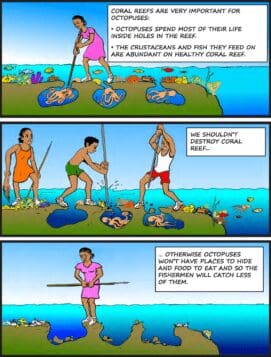
Comics are also effective outreach.
We’re coupling this film with workshops in schools, group discussions with adults, and other outreach materials (one of which, the comic, can be seen in the film itself). In the end it’s about removing the pressures that make it more tempting to break up the reef or take the smaller octopus, whether it’s through providing access to livelihood alternatives such as seaweed and sea-cucumber farming or sparking a collective shift towards thinking about the future benefits of leaving those octopus there as opposed to today’s benefits of taking them. The comic for instance focuses less on the destructive practices and more on the life cycle of the octopus and the benefits of good practices.
What projects do you have on the cards next?
Paul: We’ve been training a few young people – fishermen and former students – to make films themselves. They have been tasked with thinking about issues that are facing them as fishermen and as a community, and are set to propose some ideas for film projects in the coming months.
One project in the pipeline is to produce a picture book that will explain in detail how the dina works – how it is designed, and how it is implemented. We will accompany this with another engaging film, building on the success of “Tovo”, that will tell more of a personal story about the people involved in reporting dina infractions, and the challenges of applying the fines on other community members.
What did making this film mean for you personally?
Paul: The whole experience of this film has been incredible, from Xavier’s conception of it until even now still being asked to put this film onto SD cards and USB keys anytime I pass through a village. I can’t rave enough about all of the people involved, but Xavier really proved how effective and efficient you can be if you’re thinking about putting the community first. This film was created fully alongside the community for the community. It’s creation was extremely low budget, virtually no cost outside of the car ride to get Xavier to Andavadoaka to shoot it. It was completely shot in just three days, with Xavier editing it every night after shooting. By the time he left Andavadoaka, which was only 4 days after starting it, he had already produced a rough edit of the film. I’ve never seen anything like such a quick turn around. Within two weeks we showed the final edit for the first time for a crowd of over 400 people. It was truly inspiring and showed us what can be accomplished in just a small amount of time and with very few resources.
Xavier: I’ve been living in the Toliara Region for more than 8 years, and working for Blue Ventures for two of those, visiting the coast around Andavadoaka regularly. Some of the destructive fishing practices I saw worried me, as I know the impact they will have on the fishery and people’s livelihoods in the long term. I’d seen more ‘traditional’ style outreach efforts fail, and wanted to make something much more engaging and fun that would have more chance of making an impact. This film was one of my last major projects with Blue Ventures, before I moved to Belgium to start a new chapter in my life and career. It was amazing to be able to leave on a high with echoes of the audience’s laughter and singing ringing in my ears. I’m going to stay closely in touch with my colleagues in Madagascar and hope to be able to contribute again to future films in this series!
You’ve heard all about it, now watch the Vezo blockbuster “Tovo the Octopus Gleaner”!
We would like to give special thanks to the John D. and Catherine T. Macarthur Foundation for supporting this initiative.


